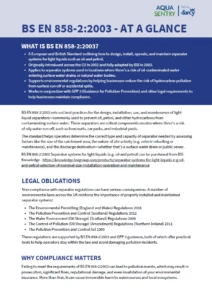
What Is BS EN 858-2:2003?
- A European and British Standard outlining how to design, install, operate, and maintain separator systems for light liquids such as oil and petrol
- Originally introduced across the EU in 2002 and fully adopted by BSI in 2003
- Applies to separator systems used in locations where there’s a risk of oil-contaminated water entering surface water drains or natural water bodies
- Supports environmental regulations by helping businesses reduce the risk of hydrocarbon pollution from surface run-off or accidental spills
- Works in conjunction with GPP 3 (Guidance for Pollution Prevention) and other legal requirements to help businesses maintain compliance.
BS EN 858-2:2003 sets out best practices for the design, installation, use, and maintenance of light liquid separators—commonly used to prevent oil, petrol, and other hydrocarbons from contaminating surface water. These separators are critical components on sites where there’s a risk of oily water run-off, such as forecourts, car parks, and industrial yards.
The standard helps operators determine the correct type and capacity of separator needed by assessing factors like the size of the catchment area, the nature of site activity (e.g. vehicle refuelling or maintenance), and the discharge destination—whether that’s a surface water drain or public sewer. BS EN 858-2:2003 Separator systems for light liquids (e.g. oil and petrol) can be purchased from BSI Knowledge.
Legal Obligations
Non-compliance with separator regulations can have serious consequences. A number of environmental laws across the UK reinforce the importance of properly installed and maintained separator systems:
- The Environmental Permitting (England and Wales) Regulations 2016
- The Pollution Prevention and Control (Scotland) Regulations 2012
- The Water Environment (Oil Storage) (Scotland) Regulations 2006
- The Control of Pollution (Oil Storage) (Amendment) Regulations (Northern Ireland) 2011
- The Pollution Prevention and Control Act 1999.
These regulations are supported by BS EN 858-2:2003 and GPP 3 guidance, both of which offer practical tools to help operators stay within the law and avoid damaging pollution incidents.
Why Compliance Matters
Failing to meet the requirements of BS EN 858-2:2003 can lead to pollution events, which may result in prosecution, significant fines, reputational damage, and even invalidation of your environmental insurance. More than that, it can cause irreversible harm to watercourses and local ecosystems.
We’ve seen firsthand how neglecting separator maintenance—whether through improper installation, lack of servicing, or missing alarms—can expose businesses to major operational risks. That’s why we recommend proactive compliance, not just as a legal requirement, but as a commitment to responsible environmental stewardship.
Maintenance and Monitoring Requirements
The standard outlines key responsibilities for operators, which we help our clients meet. These include:
- Automatic alarm systems – Separators should be fitted with alarms to detect high oil levels and alert operators before an incident occurs
- Routine servicing – A minimum of twice-yearly servicing for active systems is essential
- Integrity testing – Separators should be emptied and undergo a full inspection every five years to assess their integrity and performance. After inspection, they must be refilled with clean water
- Record keeping – All maintenance, cleaning, and repair work must be logged and retained. Records should be available for inspection upon request and should include details of any system failures or unusual activity.
By keeping your separator systems maintained and alarm systems functional, you’re in a stronger position to demonstrate due diligence to regulators.
How We Can Help
As your dedicated environmental services provider, we offer:
- Comprehensive separator servicing and maintenance
- Installation and testing of separator alarm systems
- Scheduled inspection and integrity checks
- Assistance with record-keeping and regulatory compliance.
We act as your environmental compliance partner, ensuring your business meets its responsibilities under BS EN 858-2:2003 and stays ahead of potential issues.
Four Steps to Compliance with BS EN 858-2:2003
- Ensure all separators are installed and commissioned according to BS EN 858-2:2003
- Keep up with routine maintenance and ensure all separator alarms are operational
- Maintain detailed records of inspections, services, and incidents
- Partner with experienced professionals to manage inspections, testing, and remedial work.
Get in Touch With Our Experts
If separator maintenance and BS EN 858-2:2003 compliance is currently a consideration for you, don’t hesitate to get in touch with us, and we will be happy to discuss our solutions with you.

Sign up for the latest news and offers


